You found an expired bag of chia seeds and you’re not sure if you can use them. That begs the question: do chia seeds go bad, and how to tell?
Fortunately for you, chia seeds usually last way past the date on the label. Think months (or even years), not weeks.
But it’s also important to know when yours are done for. And that’s not always obvious.
In this article, we’re going to cover storage, shelf life, and spoilage of chia seeds. If you’re looking for that kind of info, read on.
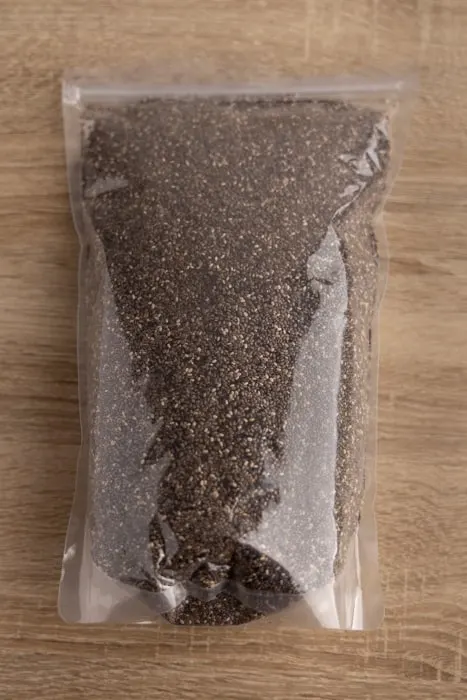
Do Chia Seeds Go Bad? How To Tell They Are Bad?
Chia seeds go bad eventually. Even if you store them properly, at some point, they will go rancid, and that’s when you throw them out.
But if your storage habits aren’t all that great, your chia seeds might form clumps, grow mold, or be infested by pantry bugs. Any one of these is a good enough reason to discard the seeds.
That’s the short version – let’s get into some details.
Pantry Insects
While pantry bugs are typically associated with products such as rice or flour, you can find them in any bag in the pantry or kitchen.
If you find any dead or alive insects, eggs, or larvae, toss the chia seeds. While eating any of those isn’t necessarily a health risk, I’m fairly sure you’d rather avoid that extra bit of protein.
If you spot any of these in the cupboard, cleanse the perimeter as soon as possible. Pantry insects spread fast, and you don’t want them to infest all the other foods you have there, like pancake mixes, oatmeal, or quinoa bags.
If you have an issue with pantry bags, using airtight storage containers should help.
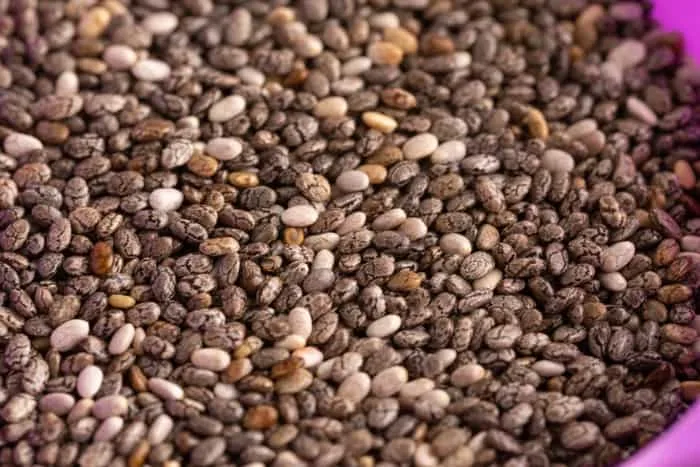
Rancidification
Chia seeds are high in antioxidants, thanks to which they last for much longer than other high-fat products. But, like pretty much all seeds (e.g., flax or sesame), they go rancid eventually.
The usual signs of rancidity include an off (chemical, maybe paint-like) smell and a sour or bitter taste.
However, chia seeds don’t have a very distinct smell. Maybe some nutty notes, but that’s it. And they taste pretty neutral too.
Because of that, you won’t notice that change of smell right away. And since most recipes use only a small amount of chia seeds and tons of other ingredients (think fruits, nuts, and so on), the difference in taste might also be difficult to spot.
Fortunately, you can get around this issue and test if your chias are rancid. There are two options:
- Crush some seeds using a mortar and pestle and give it a sniff. A sour, rancid, or any other off smell means they’re rancid.
- Soak a teaspoon of seeds in 6 teaspoons of water overnight, and taste the gelled mixture. If it’s sour or has a harsh taste, the seeds are rancid.
Do you have to discard rancid chia seeds?
Not necessarily. There’s little data on health effects of eating rancid foods, and you’re probably going to be okay if you eat a little every now and then. But eating rancid chia seeds day in day out just to use the whole package most likely isn’t a good idea.
Mold and Wet Clumps
Chia seeds don’t clump even if they’re stored for a long time. If yours do, take a closer look at those lumps, and look for any signs of any organic growth (e.g. mold), or if they are wet.
If either is the case, discard the whole container or bag. Scooping out the spoiled mass and eating the rest isn’t a good idea.
One more thing – chia seeds tend to stick to plastic bags. That’s static electric charge and nothing to worry about. Removing those seeds from the bag might be frustrating, but that’s about it.
I included the last bit because I read somewhere that you should discard chia seeds if they stick to the bag. That’s bonkers.
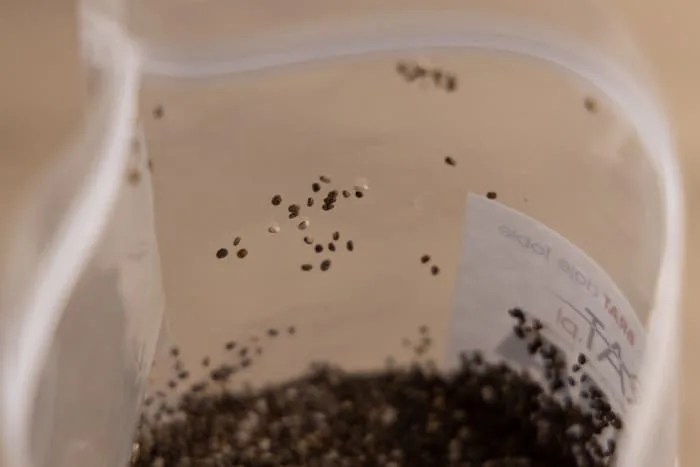
How Long Do Chia Seeds Last?
Chia seeds come with a shelf life of about 18 to 24 months and tend to retain quality for at least 3 to 6 months after the date on the label.
Opening the package introduces fresh air to the seeds, which speeds up oxidation (and therefore rancidification), but it’s not that big of a deal if you keep the seeds in a sealed bag or container.
“Expiration” Date
The date on the label is a best-before or best-by date, and it’s by no means an expiration date. Instead, it’s there to inform you how long the seeds should retain optimal quality.
As I already mentioned, if you store your chias properly, they will last in good quality far beyond what the package says. And by far beyond I mean months, or even years.
Of course, the sellers recommend you buy a new pack when your seeds are “expired.” It’s up to you whether you follow that advice or not.
If your chia seeds are way past their date, I suggest you check them for rancidity before using them. I described how to go about that process in the section on spoilage.
Chia Seed Pudding
Chia seed pudding typically keeps for up to 5 days in the fridge. It depends a bit on what other ingredients your recipe uses, but 5 days is the standard here.
Some example recipes include this one from Minimalist Baker, and this one from Cookie and Kate, both of which recommend storing the pudding for no longer than 5 days.
Of course, you can also go with the standard USDA advice to use the leftovers within 4 days. Up to you.
All the same storage advice applies to soaked chia seeds, too.
It’s always best to check what the recipe’s author says about storage time. If there’s no info, or you can’t be bothered looking for it, assume it’s 4 to 5 days.
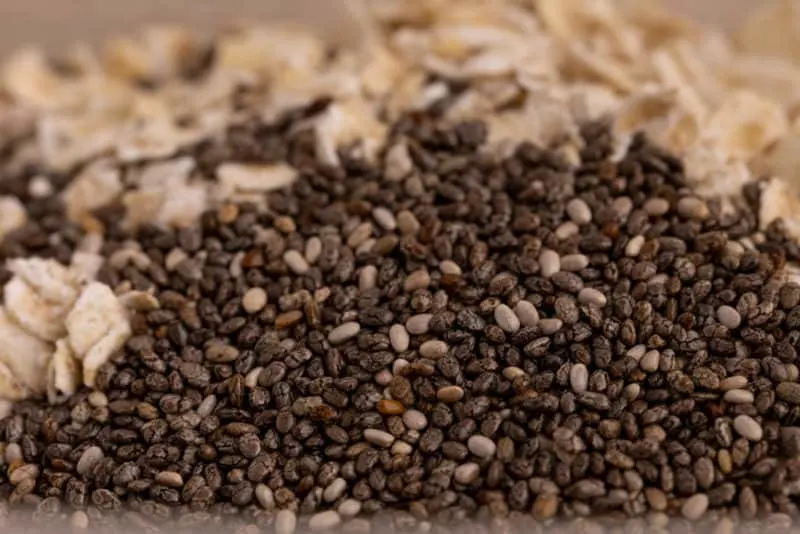
How To Store Chia Seeds
Store chia seeds at room temperature, sealed tightly and away from sunlight. Once you first open the bag, transfer the seeds into something airtight if the original bag isn’t resealable.
As you can tell, chia seeds don’t require much in terms of storage – a cupboard in the pantry or kitchen at room temperature is good enough.
Sealed Container
Like with any fat-rich product, the easiest way to extend its shelf life is to store it in an airtight container.
If your chia seeds don’t come in a resealable pouch, transfer them into something that you can seal after you open that bag.
Some people prefer mason jars, others use freezer bags or airtight containers. Anything that’s resealable will restrict the access to fresh air and therefore slow down rancidification. And that’s what we’re after.
Refrigeration
You can refrigerate chia seeds, but that’s not necessary.
Refrigerating chia seeds extends their shelf life the same way keeping your olive oil in the fridge helps it retain quality for longer. Once again, it’s all about slowing down rancidification.
If you want to store your chia seeds for months past the date on the label, and have space in the fridge to spare, feel free to refrigerate them.
There’s one caveat here, though – make sure the seeds are well sealed. Refrigerators tend to be quite humid and smelly, and dry foods like to absorb moisture and smells from the environment. You want to avoid that, and a tight seal is the way to go.
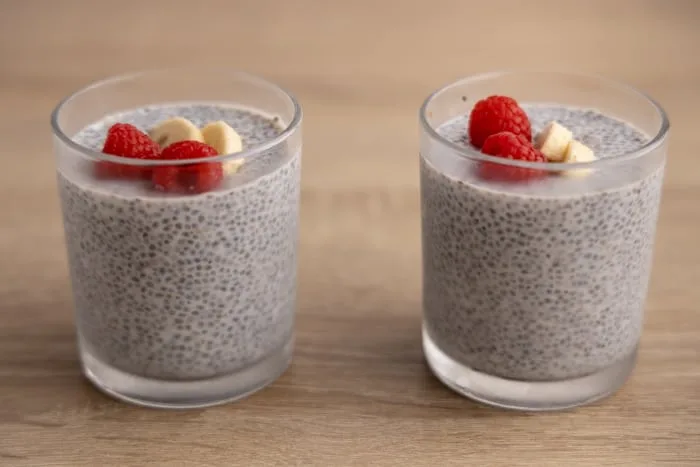
Soaked Chia Seeds
Soaked chia seeds require refrigeration and a tight seal. That’s true for soaked chia seeds, chia juice, chia pudding, or what have you.
Leaving any of those on the counter isn’t a good idea, and you should follow the 2-hour rule: if it sits for more than 2 hours at room temperature, it’s not safe to eat. That’s especially true if those soaked chias are in an uncovered bowl, or anything else that’s not sealed.
While you probably don’t have to follow the 2-hour rule to a T (I don’t), you definitely shouldn’t leave soaked chia seeds on the counter if that’s not necessary.
Can You Freeze Chia Seeds?
You can freeze chia seeds, but it doesn’t come with any tremendous benefits. Sure, you can extend their already long shelf life by at least a couple of years, but you probably don’t need to do that.
I think freezing chia seeds makes sense only if you’re a prepper, or you’ve bought way too much and have all the freezer space in the world. If either is the case, be my guest and freeze them.
Here’s how:
- Transfer the chia seeds into resealable bags. Squeeze out any air before sealing.
- Place the bags into the freezer.
If you find it useful, you can label each bag with a name and date. Or chuck those bags into airtight containers to make organizing your freezer a bit easier.
While I don’t think freezing raw chia seeds is useful, there are some other options for freezing chia seeds worth exploring.
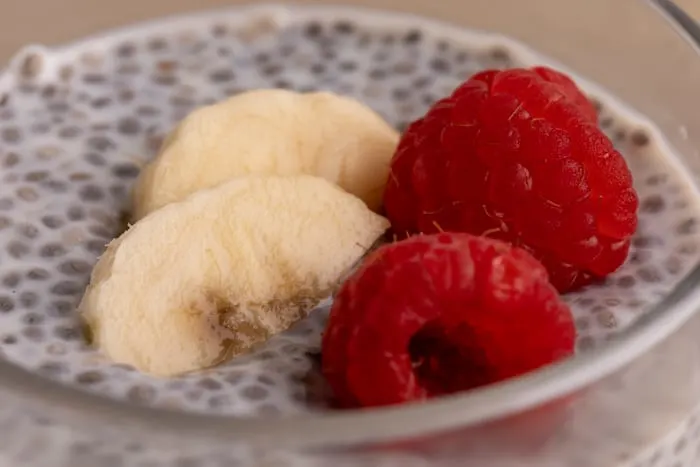
Freezing Chia Seed Pudding
You can freeze chia seed pudding, and that’s a great way to save time when making this treat.
The whole process is as simple as making the pudding, portioning it into single-serving containers, and placing the containers in the freezer. This way, you defrost only as many servings as you need.
If you top the pudding with fresh fruit, they will be soft and kind of watery after thawing. If you’re not okay with that, add the fruits after defrosting the pudding.
When it comes to defrosting, place in the fridge the container you want to thaw the night before you want to eat the pudding. It should be thawed in the morning.
If you’re looking for some inspiration for chia pudding that you can freeze, here’s a great guide by Lisa from Downshiftology.
Difference Between Black and White Chia Seeds
There isn’t much difference between black and white chia seeds, both nutritionally and storage-wise. In other words, all of the suggestions you can find in this article work for both varieties.
Probably the most noticeable difference is the price. White chia seeds are more rare than black ones, and therefore come at a higher cost.
If white-colored seeds look better in your recipes, and you’re happy to pay a bit more, feel free to buy them. Otherwise, it’s probably not worth it.